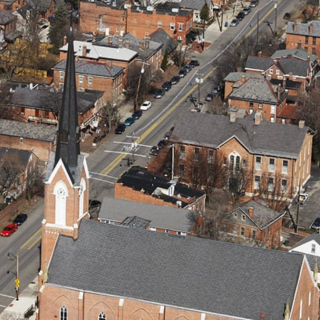Advertisement
When it comes to Columbus’s new district system for City Council, Eastside activist Jonathan Beard pulls no punches.
“I started calling this ‘Columbabama.’ This is repackaged 1950’s Jim Crow,” he says. “These fake districts were Shannon Hardin’s effort to confuse the ballot, claim responsiveness to an issue, and preserve white money and white voters’ influence over who represents Black folk in Columbus.”
In 2016, Beard unsuccessfully tried to bring true representative districts to Columbus. His non-profit Everyday People For Positive Change spent $13,000 while the City spent over $1 million to distort and then defeat the citizen-initiated vote.
“Our proposal simply sought to enlarge the size of council and bring real council districts to the city. Columbus is the only big city in America to retain an all-at-large election system,” he says.
Beard has done the research: The at-large vote for City Council – or, as he sees it, the deliberate marginalization of Black electoral power in Columbus – was put in place over a century ago. The Columbus City Charter, its constitution, was approved by voters in 1914. It created the current seven at-large Councilmembers, which of course will end after the votes are counted on November 7.
Even back then there were warnings about an at-large vote for City Council.
“The laboring men will not be benefited or represented in a council of seven men elected at large, four of whom, at lease, will be corporation hand-picked,” stated George D. Jones to the Columbus Evening Dispatch, the City’s assistant law director in 1914.
As activists have repeatedly vocalized, the new district system is a “fake district system” because the vote is still at-large. Black activist candidate Adrienne Hood is running against incumbent Emmanuel Remy (a white realtor) in District 4, which encompasses the Northside, North and South Linden, Brittany Hills, and the street where her son was killed by Columbus police “jump out boys.” But even if she wins in District 4, she needs to win the at-large vote to be elected.
“If it were just my district to win, I’d have a huge chance of winning,” said Ms. Hood to the Free Press.
The new District system, proposed by City Council, was approved by voters in 2018. Only three other much smaller US cities have such a system. Activists say voters were “bamboozled” by City Council. Even the NAACP Legal Defense Fund weighed in, “Only one Black candidate, Jennette Bradley [in 1991 as a Republican], has been elected to the City Council in recent history without special circumstances being present. All of the Black members currently serving on the City Council were initially appointed and subsequently elected to the council as incumbents.”
Beard has watched City Council appoint good Black folk into positions of influence for decades. But says it’s a “fallacy believing the endless appointments of Black Councilmembers have been to promote Black community interests.”
“I see it as a continuance of the City’s longstanding practice of white-washing Black interests, by having Black folk preside over issues that structurally disenfranchise Black voices, and in this case [new districts], systematically disenfranchise Black voters,” he said.
What leaves Beard in disbelief and with questions are the moves – as in literally – some Black office holders may have made to keep the (white) status quo in power and control.
The new district system requires candidates and City Council members to live in their district. Beard points out that Council President Shannon Hardin, and Councilmembers Nic Bankston and Shayla Favor (all African American), were all living in the historically Black Near East Side when the new district system won in 2018. After the districts were mapped out by City Council, all three incumbents were living in what is now District 7, which runs from Bexley through downtown, around Grandview and down to the southwest outer belt up to Grove City and Urbancrest.
But then Hardin moved from his home in District 7 to a new home in District 9. Bankston then followed suit, so to speak, when he moved from District 7 to District 5. Favor remains in District 7.
“I’m not saying that anybody moved for the sole purpose of noncompetition but given other Council actions around elections it does raise questions and call the legitimacy of our governance into further question,” said Beard. “I don’t have high expectations for representative government here in Columbus.”
In many ways its fate that Adrienne Hood – an outlier, an activist candidate whose son was unnecessarily killed by Columbus police – is challenging the “fake” district system as it comes up for its first ever vote.
During a recent candidate forum at the Main Library, Hood told the audience that since her son’s death in 2016, “she’s learned a lot about policy, or the lack of.”
“When it comes to accountability, it’s not just about accountability for our police officers but it’s also about the accountability for our elected officials. And so because of the things that I have learned, you can either complain about it, or you can try to be part of the solution. And I too am trying to part of the solution,” she said.



